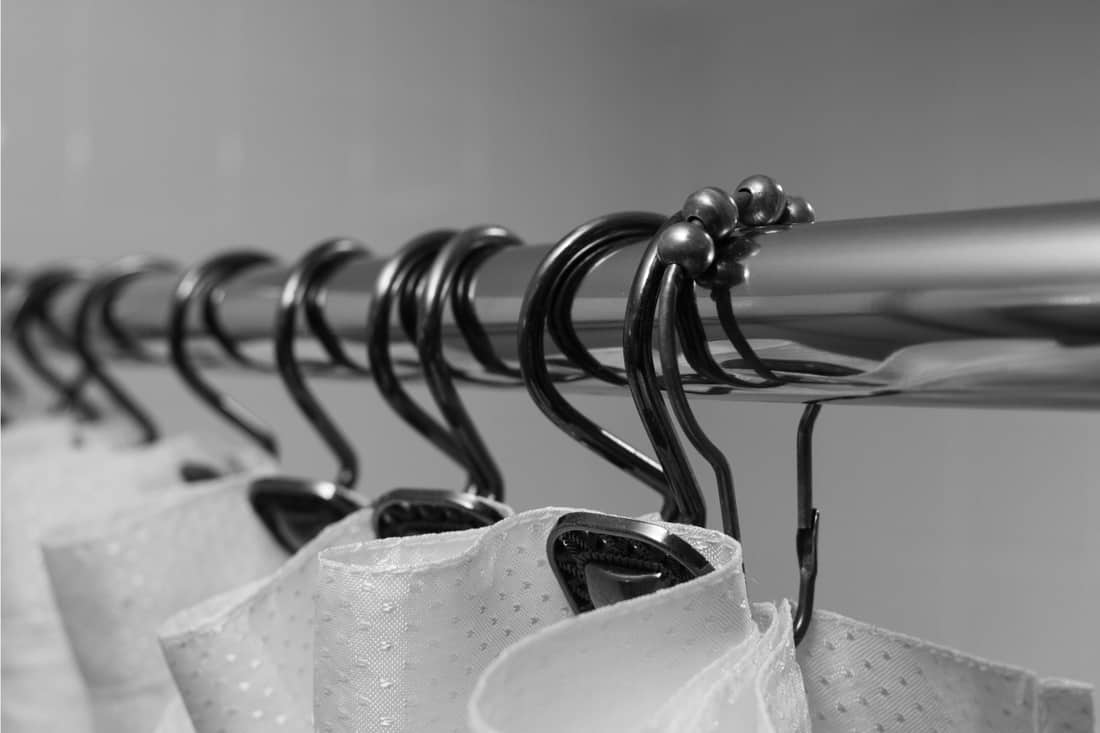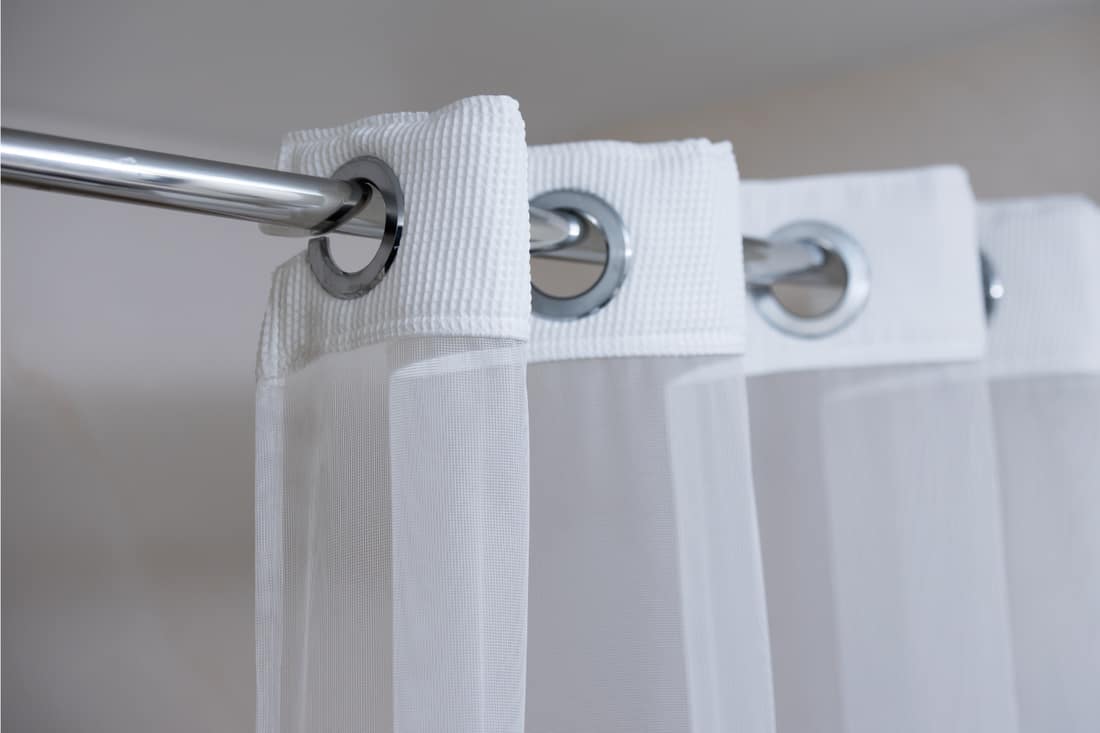Shower curtains are decorative and functional. They tie together your beautiful bathroom design while keeping your floors dry. You may wonder about how to hang a shower curtain and whether you need to use hooks to hang it. You’re in luck! We’ve done the research and have plenty of tips on how to hang a shower curtain with or without hooks.
There are several ways to hang a shower curtain. You can choose what to hang it on, including:
- Tension rod
- Mounted rod, or
- Clothesline
You can also choose how to hang the curtain, including:
- Hooks
- Rings, or
- Directly on the rod
In this post, we will cover each of these options in detail. Every situation is different, so it’s important to figure out what curtain hanging method will work best for your bathroom. We’ll also discuss the logistics of hanging a shower curtain and how often to clean and replace it.
How To Hang A Shower Curtain
There are many ways to hang a shower curtain. Consider what works best for water control in your space, and consider how your shower curtain will fit the overall look of your bathroom.
Measure The Space And The Curtain
The first step of any home improvement project is to take measurements. The standard shower curtain size is 72 inches by 72 inches, but be sure to double-check those measurements because they do vary. Measure your shower curtain liner as well – ideally, the shower curtain and liner will be the same size.
Next, measure the space around your tub. Measure the space between the two walls where the curtain rod will sit to ensure that the rod is long enough to cover that distance.
Then, measure the height. A shower curtain rod should be installed about 4-8 inches higher than the length of the shower curtain itself, which is about 75-80 inches from the tub floor. Measure this distance on both sides and mark the spot on the wall where you are going to install the shower curtain rod.
How To Install A Tension Rod
The next step is to install the curtain rod itself, and here you have some choices. A tension rod is a great option for shower curtain installation because it is easy to install and fits into a variety of spaces. Most tubs are at least 60 inches wide, so you will need a rod that is slightly longer than that.
To install a tension rod, extend the rod by twisting it counterclockwise to lengthen. If you extend it too far, you can twist clockwise to shorten it. Extend the rod until it fits the space, and then adjust the ends so that they meet your marked installation spots. Then continue to expand the rod until it feels secure. Here are two tension rod options, one in aluminum and one in stainless steel:
Click here to see this product on Amazon.
Click here to see this product on Amazon.
How To Install A Mounted Rod
A mounted rod is attached to brackets rather than directly to the wall. It is important to know the exact distance between your two walls so you can get a rod that is the correct length. Most mounted rods are somewhat adjustable.
A mounted rod is installed into brackets, which are usually included with the purchase of the rod. The first step is to install the brackets on the installation marks you measured. Next, fit each end of the rod into the brackets. Finally, pull lightly on the rod to make sure it is secure.
Click here to see this product on Amazon.
How To Install A Clothesline
If you prefer not to use a curtain rod to hang your shower curtain, a clothesline is another good option. First, attach a hook to the wall at each of the marked installation points you measured.
Click here to see these hooks on Amazon.
Next, cut a length of clothesline 12 inches longer than the length of the tub. Loop 6 inches through one of the hooks. Weave the other end through the holes or grommets on the shower curtain and liner. Then, loop the last 6 inches of clothesline through the other hook. Pull the clothesline taut and knot it at the end. If you’d like, you can trim the ends of the clothesline on both sides for a neater look.
Click here to see this product on Amazon.
Hang The Curtain With Hooks

If you are using a tension rod or mounted rod, it is now time to hang your shower curtain and liner. Place the shower curtain rings or hooks on the curtain rod, but do not close them. If the rings or hooks have a decorative element, make sure it is facing out into the room and not into the shower. Shower curtain rings or hooks are usually made of either plastic or metal.
Click here to see these hooks on Amazon.
Click here to see these rings on Amazon.
With the liner on the inside of the tub, thread the holes or grommets on the shower curtain and liner through the hooks or rings. Start on one side and continue all the way to the other side. Close each ring after you have threaded the curtain and liner through it. Finally, pull lightly on the curtain and liner to confirm that the rod is holding the weight securely, and check to make sure the curtain and liner slide smoothly along the curtain rod.
Hook-Free Options

If you prefer to avoid using hooks or rings, there are hook-free options available for hanging your shower curtain. You can use the clothesline method described above, in which the curtain is hung directly on the clothesline. There are also hook-free shower curtains available. These curtains have rings built into the curtain itself, so they can attach directly to the curtain rod.
Click here to see this shower curtain on Amazon.
Many hook-free shower curtains come with a snap-on liner that attaches to the curtain itself rather than the curtain rod. This can be a useful option because you can easily replace the shower curtain liner by snapping the old one off and snapping the new one on.
Click here to see this liner on Amazon.
How High Should You Hang A Shower Curtain?

A standard 72-inch x 72-inch shower curtain should be hung 75-80 inches from the floor. The bottom of the curtain should hang at least 5-6 inches below the edge of the tub to avoid flooding and several inches above the floor to avoid dirt. Some people prefer to have the curtain brush the floor for aesthetic purposes. If this is your preference, hang the curtain rod 72 inches from the floor.
Be sure to take the size of your curtain hooks or rings into consideration. If they are large, they can extend the curtain length by 1-3 inches.
Do Shower Curtains Go Inside Or Outside A Tub?

The shower curtain goes on the outside of the tub, and the shower curtain liner goes on the inside of the tub. The back side of the curtain faces the liner, and the magnets on the liner (if applicable) should face the wall of the tub.
If you are only using a single curtain, it should go inside the tub to avoid water spilling out of the tub. Keep in mind that a shower curtain that hangs inside the tub can soak in moisture and soap residue, which can cause mold. Mold and mildew growth can create a health risk for you and your family over time, so be sure to clean and replace your shower curtain and liner regularly.
How Do You Keep The Shower Curtain From Blowing In?
The air pressure inside the shower may cause your shower curtain or liner to blow into the tub and stick to you, which can be annoying! Many shower curtain liners come with magnets or weights on the bottom that help them stick to the side of the tub so they won’t blow in. If your liner does not come with magnets, you can attach some to the bottom.
Click here to see this product on Amazon.
Shower curtain clips are another effective solution. These clips stick to the bathroom wall and hold the shower curtain in place.
Click here to see this product on Amazon.
A curved shower curtain rod can also keep the curtain from blowing in by changing the angle of the air pressure inside the tub.
Click here to see this product on Amazon.
What Is The Best Fabric For A Shower Curtain?
Shower curtains can be made of several different materials. In most cases, it is important to choose an opaque material to ensure privacy. You can also choose a shower curtain color and material that match your overall bathroom design.
Plastic is a cheap and easy material option, especially for a shower curtain that you plan to replace fairly often.
Click here to see this product on Amazon.
Shower curtains also come in fabric materials. These materials look more formal, and they may be better suited to some bathroom aesthetics. This polyester option is water-repellent and mildew-resistant.
Click here to see this product on Amazon.
This microfiber option is a soft material that is nice to touch. It also repels water and is machine washable.
Click here to see this product on Amazon.
Shower curtain liners are generally made of plastic or vinyl. They tend to be transparent and thin to allow light and airflow in the bathroom. Keep in mind that shower curtain liners are replaced regularly, so they do not need to be very expensive or durable.
Click here to see this liner on Amazon.
How Often Should You Change Your Shower Curtain?
Shower curtains should be cleaned or replaced when they are dirty or when mold and mildew have built up. Most fabric shower curtains can go in the washing machine. They should be cleaned every few weeks and replaced once a year. Similarly, plastic shower curtains should be washed by hand once a month and replaced once a year.
Your shower curtain liner should be cleaned at least monthly and replaced every six months. If your bathroom has poor ventilation or if you live in a particularly humid environment, consider replacing your shower curtain and liner more often.
Find The Best Method For Your Space
As we have discussed in this post, there are many ways to hang a shower curtain. You can certainly use hooks on a curtain rod, but you don’t need to be limited by that traditional method. Considering logistics and aesthetics will help you find the shower curtain and hanging method that works best for your bathroom.















